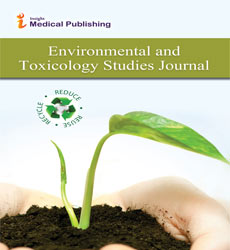Toxicological Effects of Persistent Organic Pollutants: Mechanistic Insights and Global Risk Assessments
Shanshan Zing*
Department of Toxicology and Pharmacology, Naval Medical University, Shanghai, China
*Corresponding author:
Shanshan Zing,
Department of Toxicology and Pharmacology, Naval Medical University, Shanghai, China,
E-mail: shanshan@zing.cn
Received date: February 01, 2025, Manuscript No. IPETSJ-25-20612; Editor assigned date: February 03, 2025, PreQC No. IPETSJ-25-20612 (PQ); Reviewed date: February 15, 2025, QC No. IPETSJ-25-20612; Revised date: February 22, 2025, Manuscript No. IPETSJ-25-20612 (R); Published date: February 28, 2025, DOI: 10.36648/.9.1.4
Citation: Zing S (2025) Toxicological Effects of Persistent Organic Pollutants: Mechanistic Insights and Global Risk Assessments. Environ Toxicol J Vol.9 No.1:4
Introduction
Persistent Organic Pollutants (POPs) are a class of highly stable, bio accumulative chemicals that persist in the environment and resist natural degradation processes. Common POPs include Polychlorinated Biphenyls (PCBs), dioxins, organ chlorine pesticides, and polybrominated flame retardants, which can travel long distances and concentrate in the food chain. Due to their stability and lipophilicity, POPs accumulate in human and animal tissues, eliciting diverse toxicological effects. Understanding their mechanisms of action and assessing global exposure risks are essential for protecting human health, guiding environmental policy, and implementing international agreements such as the Stockholm Convention [1].
Description
POPs exert toxic effects through multiple molecular and cellular pathways. Many act as endocrine disruptors, mimicking or antagonizing natural hormones, which can alter reproductive, developmental, and metabolic processes. Others induce oxidative stress, inflammation, and genotoxicity, contributing to cardiovascular, hepatic, and neurological disorders. The lipophilic nature of POPs allows accumulation in adipose tissue, creating a long-term internal reservoir that prolongs exposure and complicates detoxification [2].
Mechanistic studies using in vitro models, animal studies, and molecular biomarkers have illuminated these pathways, highlighting dose-dependent and sometimes non-monotonic effects that challenge traditional toxicological assumptions. Global risk assessments reveal widespread human exposure to POPs through contaminated air, water, soil, and food, with high levels detected in regions far from original sources due to atmospheric and oceanic transport [3].
Vulnerable populations, including pregnant women, infants, and communities reliant on contaminated fish or livestock, are at particular risk of adverse outcomes. Epidemiological studies have linked chronic POP exposure to reproductive abnormalities, endocrine disruption, immune dysfunction, metabolic disorders, and certain cancers. These findings underscore the importance of monitoring programs and international coordination to mitigate exposure and protect public health [4].
Addressing POP-related risks requires integrated strategies combining regulatory action, environmental remediation, and public health interventions. Policy measures such as banning or restricting POP production, improving waste management, and enforcing food safety standards have proven effective in reducing environmental and human burden. Additionally, continued research into biomarkers of exposure and effect enhances early detection and informs risk mitigation strategies, ensuring that interventions are evidence-based and targeted to at-risk populations [5].
Conclusion
Persistent organic pollutants represent a significant global toxicological threat due to their stability, bioaccumulation, and diverse health impacts. Mechanistic insights into their endocrine, oxidative, and genotoxic effects, coupled with global risk assessments, provide a foundation for effective monitoring, regulation, and intervention. Multidisciplinary efforts integrating toxicology, environmental science, and public health are essential to reduce exposure, protect vulnerable populations, and safeguard ecosystems from the long-lasting effects of POPs.
Acknowledgement
None.
Conflict of Interest
None.
References
- Groh KJ, Dalkvist T, Piccapietra F, Behra R, Suter MJF, et al. (2015) Critical influence of chloride ions on silver ion-mediated acute toxicity of silver nanoparticles to zebrafish embryos. Nanotoxicology 9: 81–91
Google Scholar Cross Ref Indexed at
- Melvin SD, Lanctot CM, Doriean NJC, Carroll AR, Bennett WW (2018) Untargeted NMR-Based Metabolomics for Field-Scale Monitoring: Temporal Reproducibility and Biomarker Discovery in Mosquitofish (Gambusia holbrooki) from a Metal(loid)-Contaminated Wetland. Environ Pollut 243: 1096–1105
Google Scholar Cross Ref Indexed at
- Bouhifd M, Hartung T, Hogberg HT, Kleensang A, Zhao L (2013) Review: Toxicometabolomics. J Appl Toxicol 33: 1365–1383
Google Scholar Cross Ref Indexed at
- Denslow ND, Griffitt RJ, Martyniuk CJ (2012) Advancing the Omics in Aquatic Toxicology: SETAC North America 31st Annual Meeting. Ecotoxicol Environ Saf 76: 1–2
Google Scholar Cross Ref Indexed at
- Zhang ML, Zou YT, Xiao S, Hou J (2023) Environmental DNA Metabarcoding Serves as a Promising Method for Aquatic Species Monitoring and Management: A Review Focused on Its Workflow, Applications, Challenges and Prospects. Mar Pollut Bull 194: 115430
Open Access Journals
- Aquaculture & Veterinary Science
- Chemistry & Chemical Sciences
- Clinical Sciences
- Engineering
- General Science
- Genetics & Molecular Biology
- Health Care & Nursing
- Immunology & Microbiology
- Materials Science
- Mathematics & Physics
- Medical Sciences
- Neurology & Psychiatry
- Oncology & Cancer Science
- Pharmaceutical Sciences
